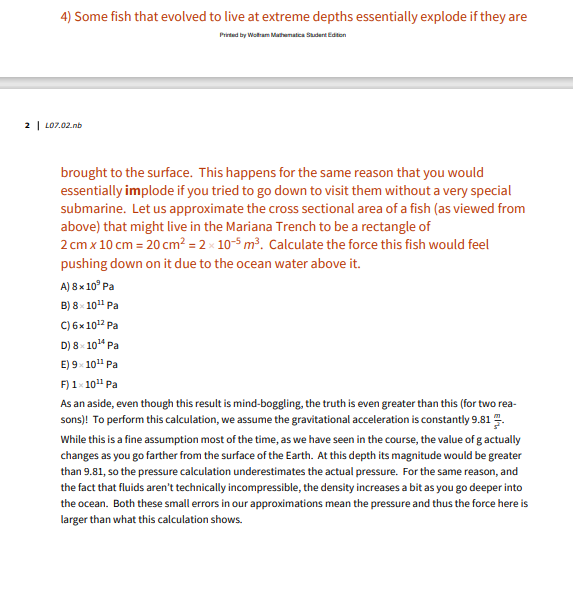4) Some fish that evolved to live at extreme depths essentially explode if they are Petad by an atumatca dert tten 2 | L07.02.nb brought to the surface. This happens for the same reason that you would essentially implode if you tried to go down to visit them without a very special submarine. Let us approximate the cross sectional area of a fish (as viewed from above) that might live in the Mariana Trench to be a rectangle of 2 cm x 10 cm = 20 cm² = 2 × 10-5 m³. Calculate the force this fish would feel pushing down on it due to the ocean water above it. A) 8 x 10° Pa B) 8 - 10" Pa C) 6x10" Pa D) 8 - 10“ Pa E) 9- 10" Pa F) 1- 10 Pa As an aside, even though this result is mind-boggling, the truth is even greater than this (for two rea- sons)! To perform this calculation, we assume the gravitational acceleration is constantly 9.81 : While this is a fine assumption most of the time, as we have seen in the course, the value of g actually changes as you go farther from the surface of the Earth. At this depth its magnitude would be greater than 9.81, so the pressure calculation underestimates the actual pressure. For the same reason, and the fact that fluids aren't technically incompressible, the density increases a bit as you go deeper into the ocean. Both these small errors in our approximations mean the pressure and thus the force here is larger than what this calculation shows.
4) Some fish that evolved to live at extreme depths essentially explode if they are Petad by an atumatca dert tten 2 | L07.02.nb brought to the surface. This happens for the same reason that you would essentially implode if you tried to go down to visit them without a very special submarine. Let us approximate the cross sectional area of a fish (as viewed from above) that might live in the Mariana Trench to be a rectangle of 2 cm x 10 cm = 20 cm² = 2 × 10-5 m³. Calculate the force this fish would feel pushing down on it due to the ocean water above it. A) 8 x 10° Pa B) 8 - 10" Pa C) 6x10" Pa D) 8 - 10“ Pa E) 9- 10" Pa F) 1- 10 Pa As an aside, even though this result is mind-boggling, the truth is even greater than this (for two rea- sons)! To perform this calculation, we assume the gravitational acceleration is constantly 9.81 : While this is a fine assumption most of the time, as we have seen in the course, the value of g actually changes as you go farther from the surface of the Earth. At this depth its magnitude would be greater than 9.81, so the pressure calculation underestimates the actual pressure. For the same reason, and the fact that fluids aren't technically incompressible, the density increases a bit as you go deeper into the ocean. Both these small errors in our approximations mean the pressure and thus the force here is larger than what this calculation shows.
Principles of Heat Transfer (Activate Learning with these NEW titles from Engineering!)
8th Edition
ISBN:9781305387102
Author:Kreith, Frank; Manglik, Raj M.
Publisher:Kreith, Frank; Manglik, Raj M.
Chapter5: Analysis Of Convection Heat Transfer
Section: Chapter Questions
Problem 5.9P: When a sphere falls freely through a homogeneous fluid, it reaches a terminal velocity at which the...
Related questions
Question
can you please do all of them. thank you

Transcribed Image Text:4) Some fish that evolved to live at extreme depths essentially explode if they are
Prirted by Woltam Mathematca Sudert Edten
2 | LO7.02.nb
brought to the surface. This happens for the same reason that you would
essentially implode if you tried to go down to visit them without a very special
submarine. Let us approximate the cross sectional area of a fish (as viewed from
above) that might live in the Mariana Trench to be a rectangle of
2 cm x 10 cm = 20 cm? = 2 × 10-5 m³. Calculate the force this fish would feel
pushing down on it due to the ocean water above it.
A) 8 x 10° Pa
B) 8 - 10" Pa
C) 6x10" Pa
D) 8 - 10“ Pa
E) 9. 10" Pa
F) 1 10" Pa
As an aside, even though this result is mind-boggling, the truth is even greater than this (for two rea-
sons)! To perform this calculation, we assume the gravitational acceleration is constantly 9.81.
While this is a fine assumption most of the time, as we have seen in the course, the value of g actually
changes as you go farther from the surface of the Earth. At this depth its magnitude would be greater
than 9.81, so the pressure calculation underestimates the actual pressure. For the same reason, and
the fact that fluids aren't technically incompressible, the density increases a bit as you go deeper into
the ocean. Both these small errors in our approximations mean the pressure and thus the force here is
larger than what this calculation shows.
Expert Solution
This question has been solved!
Explore an expertly crafted, step-by-step solution for a thorough understanding of key concepts.
This is a popular solution!
Trending now
This is a popular solution!
Step by step
Solved in 2 steps with 4 images

Knowledge Booster
Learn more about
Need a deep-dive on the concept behind this application? Look no further. Learn more about this topic, mechanical-engineering and related others by exploring similar questions and additional content below.Recommended textbooks for you

Principles of Heat Transfer (Activate Learning wi…
Mechanical Engineering
ISBN:
9781305387102
Author:
Kreith, Frank; Manglik, Raj M.
Publisher:
Cengage Learning

Principles of Heat Transfer (Activate Learning wi…
Mechanical Engineering
ISBN:
9781305387102
Author:
Kreith, Frank; Manglik, Raj M.
Publisher:
Cengage Learning